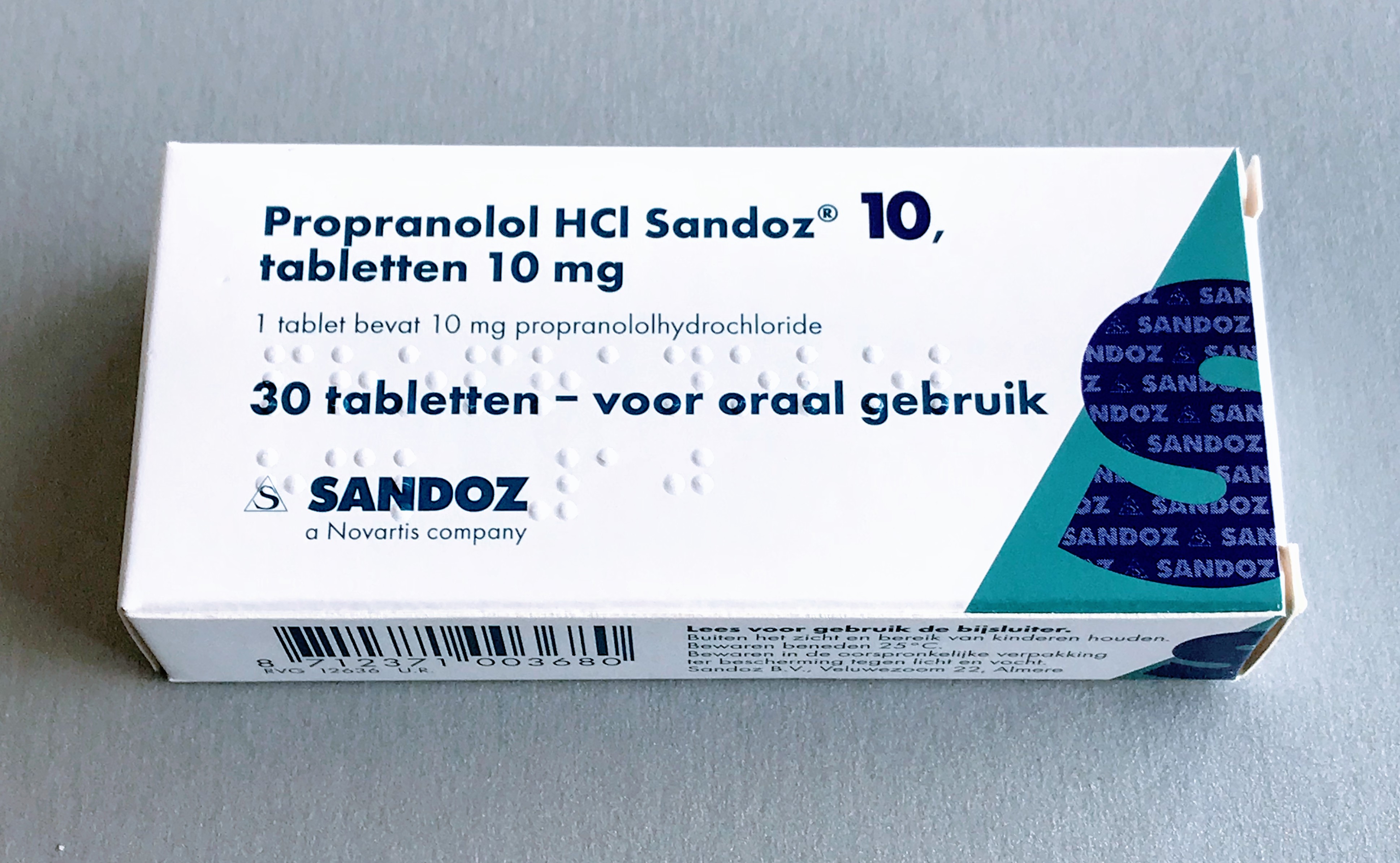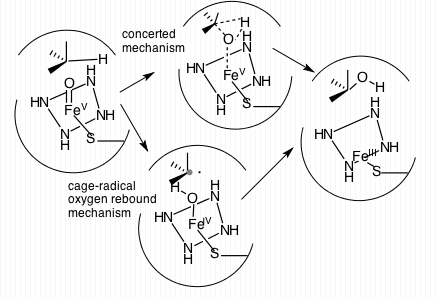|
Propranolol
Propranolol is a medication of the beta blocker class. It is used to treat hypertension, high blood pressure, some types of cardiac dysrhythmia, irregular heart rate, thyrotoxicosis, capillary hemangiomas, akathisia, performance anxiety, and essential tremors, as well to prevent migraine headaches, and to prevent further heart problems in those with angina or previous myocardial infarction, heart attacks. It can be taken oral administration, orally or by intravenous injection. The formulation that is taken orally comes in short-acting and long-acting versions. Propranolol appears in the blood after 30 minutes and has a maximum effect between 60 and 90 minutes when taken orally. Common side effects include nausea, abdominal pain, and constipation. It may worsen the symptoms of asthma. Propranolol may cause teratogen, harmful effects for the baby if taken during pregnancy; however, its use during breastfeeding is generally considered to be safe. It is a non-selective beta block ... [...More Info...] [...Related Items...] OR: [Wikipedia] [Google] [Baidu] |
Essential Tremor
Essential tremor (ET), also called benign tremor, familial tremor, and idiopathic tremor, is a medical condition characterized by involuntary rhythmic contractions and relaxations ( oscillations or twitching movements) of certain muscle groups in one or more body parts of unknown cause. It is typically symmetrical, and affects the arms, hands, or fingers; but sometimes involves the head, vocal cords, or other body parts. Essential tremor is either an ''action'' (intention) tremor—it intensifies when one tries to use the affected muscles during voluntary movements such as eating and writing—or it is a ''postural'' tremor, which occurs when holding arms outstretched and against gravity. This means that it is distinct from a resting tremor, such as that caused by Parkinson's disease, which is not correlated with movement. Unlike Parkinson's disease, essential tremor may worsen with action. Essential tremor is a progressive neurological disorder, and the most common movement di ... [...More Info...] [...Related Items...] OR: [Wikipedia] [Google] [Baidu] |
Beta Blocker
Beta blockers, also spelled β-blockers, are a class of medications that are predominantly used to manage abnormal heart rhythms ( arrhythmia), and to protect the heart from a second heart attack after a first heart attack ( secondary prevention). They are also widely used to treat high blood pressure, although they are no longer the first choice for initial treatment of most people. Beta blockers are competitive antagonists that block the receptor sites for the endogenous catecholamines epinephrine (adrenaline) and norepinephrine (noradrenaline) on adrenergic beta receptors, of the sympathetic nervous system, which mediates the fight-or-flight response. Beta-adrenergic receptors are found on cells of the heart muscles, smooth muscles, airways, arteries, kidneys, and other tissues that are part of the sympathetic nervous system and lead to stress responses, especially when they are stimulated by epinephrine (adrenaline). Beta blockers interfere with the binding to th ... [...More Info...] [...Related Items...] OR: [Wikipedia] [Google] [Baidu] |
Thyrotoxicosis
Hyperthyroidism is a endocrine disease in which the thyroid gland produces excessive amounts of thyroid hormones. Thyrotoxicosis is a condition that occurs due to elevated levels of thyroid hormones of any cause and therefore includes hyperthyroidism. Some, however, use the terms interchangeably. Signs and symptoms vary between people and may include irritability, muscle weakness, sleeping problems, a fast heartbeat, heat intolerance, diarrhea, enlargement of the thyroid, hand tremor, and weight loss. Symptoms are typically less severe in the elderly and during pregnancy. An uncommon but life-threatening complication is thyroid storm in which an event such as an infection results in worsening symptoms such as confusion and a high temperature; this often results in death. The opposite is hypothyroidism, when the thyroid gland does not make enough thyroid hormone. Graves' disease is the cause of about 50% to 80% of the cases of hyperthyroidism in the United States. Other ca ... [...More Info...] [...Related Items...] OR: [Wikipedia] [Google] [Baidu] |
Performance Anxiety
Stage fright or performance anxiety is the anxiety, fear, or persistent phobia that may be aroused in an individual by the requirement to perform in front of an audience, real or imagined, whether actually or potentially (for example, when performing before a camera). Performing in front of an unknown audience can cause significantly more anxiety than performing in front of familiar faces. In some cases, the person will suffer no such fright from this, while they might suffer from not knowing who they're performing to. In some cases, stage fright may be a part of a larger pattern of social phobia (social anxiety disorder), but many people experience stage fright without any wider problems. Quite often, stage fright arises in a mere anticipation of a performance, often a long time ahead. It has numerous manifestations: stuttering, tachycardia, tremor in the hands and legs, sweaty hands, facial nerve tics, dry mouth, and dizziness. People and situations Stage fright can occur in ... [...More Info...] [...Related Items...] OR: [Wikipedia] [Google] [Baidu] |
Akathisia
Akathisia (IPA: /æ.kə.ˈθɪ.si.ə/) is a movement disorder characterized by a subjective feeling of inner restlessness accompanied by mental distress and/or an inability to sit still. Usually, the legs are most prominently affected. Those affected may fidget, rock back and forth, or pace, while some may just have an uneasy feeling in their body. The most severe cases may result in poor adherence to medications, exacerbation of psychiatric symptoms, and, because of this, aggression, violence, and/or suicidal thoughts. Akathisia is also associated with threatening behaviour and physical aggression in mentally disordered patients. However, the attempts to find potential links between akathisia and emerging suicidal or homicidal behaviour were not systematic and were mostly based on a limited number of case reports and small case series. Apart from these few low-quality studies, there is another more recent and better quality study (a systematic review from 2021) that concludes ... [...More Info...] [...Related Items...] OR: [Wikipedia] [Google] [Baidu] |
Migraine Headaches
Migraine (, ) is a complex neurological disorder characterized by episodes of moderate-to-severe headache, most often unilateral and generally associated with nausea, and light and sound sensitivity. Other characterizing symptoms may include vomiting, cognitive dysfunction, allodynia, and dizziness. Exacerbation or worsening of headache symptoms during physical activity is another distinguishing feature. Up to one-third of people with migraine experience aura, a premonitory period of sensory disturbance widely accepted to be caused by cortical spreading depression at the onset of a migraine attack. Although primarily considered to be a headache disorder, migraine is highly heterogenous in its clinical presentation and is better thought of as a spectrum disease rather than a distinct clinical entity. Disease burden can range from episodic discrete attacks to chronic disease. Migraine is believed to be caused by a mixture of environmental and genetic factors that i ... [...More Info...] [...Related Items...] OR: [Wikipedia] [Google] [Baidu] |
CYP2D6
Cytochrome P450 2D6 (CYP2D6) is an enzyme that in humans is encoded by the ''CYP2D6'' gene. ''CYP2D6'' is primarily expressed in the liver. It is also highly expressed in areas of the central nervous system, including the substantia nigra. CYP2D6, a member of the cytochrome P450 mixed-function oxidase system, is one of the most important enzymes involved in the metabolism of xenobiotics in the body. In particular, CYP2D6 is responsible for the metabolism and elimination of approximately 25% of clinically used drugs, via the addition or removal of certain functional groups – specifically, hydroxylation, demethylation, and dealkylation. CYP2D6 also activates some prodrugs. This enzyme also metabolizes several endogenous substances, such as N,N-Dimethyltryptamine, hydroxytryptamines, neurosteroids, and both ''m''-tyramine and ''p''-tyramine which CYP2D6 metabolizes into dopamine in the brain and liver. Considerable variation exists in the efficiency and amount of C ... [...More Info...] [...Related Items...] OR: [Wikipedia] [Google] [Baidu] |
CYP2C19
Cytochrome P450 2C19 (abbreviated CYP2C19) is an enzyme protein. It is a member of the CYP2C subfamily of the cytochrome P450 mixed-function oxidase system. This subfamily includes enzymes that catalyze metabolism of xenobiotics, including some proton pump inhibitors and antiepileptic drugs. In humans, it is the ''CYP2C19'' gene that encodes the CYP2C19 protein. CYP2C19 is a liver enzyme that acts on at least 10% of drugs in current clinical use, most notably the antiplatelet treatment clopidogrel (Plavix), drugs that treat pain associated with ulcers, such as omeprazole, antiseizure drugs such as mephenytoin, the antimalarial proguanil, and the anxiolytic diazepam. CYP2C19 has been annotated as (R)-limonene 6-monooxygenase and (S)-limonene 6-monooxygenase in UniProt. Function The gene encodes a member of the cytochrome P450 superfamily of enzymes. Enzymes in the CYP2C subfamily, including CYP2C19, account for approximately 20% of cytochrome P450 in the adult liver. Thes ... [...More Info...] [...Related Items...] OR: [Wikipedia] [Google] [Baidu] |
CYP3A4
Cytochrome P450 3A4 (abbreviated CYP3A4) () is an important enzyme in the body, mainly found in the liver and in the intestine, which in humans is encoded by ''CYP3A4'' gene. It organic redox reaction, oxidizes small foreign organic molecules (xenobiotics), such as toxins or drugs, so that they can be removed from the body. It is highly homologous to CYP3A5, another important CYP3A enzyme. While many drugs are deactivated by CYP3A4, there are also some drugs that are ''activated'' by the enzyme. Some substances, such as some drugs and furanocoumarins present in grapefruit juice, interfere with the action of CYP3A4. These substances will, therefore, either amplify or weaken the action of those drugs that are modified by CYP3A4. CYP3A4 is a member of the cytochrome P450 family of oxidizing enzymes. Several other members of this family are also involved in drug metabolism, but CYP3A4 is the most common and the most versatile one. Like all members of this family, it is a hemoprote ... [...More Info...] [...Related Items...] OR: [Wikipedia] [Google] [Baidu] |
CYP1A2
Cytochrome P450 1A2 (abbreviated CYP1A2), a member of the cytochrome P450 mixed-function oxidase system, is involved in the metabolism of xenobiotics in the human body. In humans, the CYP1A2 enzyme is encoded by the ''CYP1A2'' gene. Function CYP1A2 is a member of the cytochrome P450 superfamily of enzymes. The cytochrome P450 proteins are monooxygenases which catalyze many reactions involved in drug metabolism and synthesis of cholesterol, steroids and other lipids. CYP1A2 localizes to the endoplasmic reticulum and its expression is induced by some polycyclic aromatic hydrocarbons (PAHs), some of which are found in cigarette smoke. The enzyme's endogenous substrate is unknown; however, it is able to metabolize some PAHs to carcinogenic intermediates. Other xenobiotic substrates for this enzyme include caffeine, aflatoxin B1, and paracetamol (acetaminophen). The transcript from this gene contains four Alu sequences flanked by direct repeats in the 3' untranslated region. CYP1A2 ... [...More Info...] [...Related Items...] OR: [Wikipedia] [Google] [Baidu] |
Asthma
Asthma is a common long-term inflammatory disease of the airways of the lungs. It is characterized by variable and recurring symptoms, reversible airflow obstruction, and easily triggered bronchospasms. Symptoms include episodes of wheezing, coughing, chest tightness, and shortness of breath. A sudden worsening of asthma symptoms sometimes called an 'asthma attack' or an 'asthma exacerbation' can occur when allergens, pollen, dust, or other particles, are inhaled into the lungs, causing the bronchioles to constrict and produce mucus, which then restricts oxygen flow to the alveoli. These may occur a few times a day or a few times per week. Depending on the person, asthma symptoms may become worse at night or with exercise. Asthma is thought to be caused by a combination of genetic and environmental factors. Environmental factors include exposure to air pollution and allergens. Other potential triggers include medications such as aspirin and beta blockers. Diag ... [...More Info...] [...Related Items...] OR: [Wikipedia] [Google] [Baidu] |




